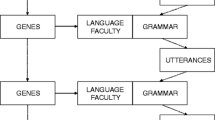Abstract
We experiment with a linguistic change mechanism in a community of interacting agents and show the various phenomena that may emerge under different social constraints. We assume phonological and lexical learning and a semantic reference to external objects in the environment. Distinct groups of agents with initially different languages converge to a common language, with the relevant frequency of inter-agent interactions controlling which language dominates. Moreover, an initially monolingual community diverges due to social factors creating agent grouping, where agents interact more frequently with members of the same group. Additional cognitive features, like innovation and attention , lead to increased linguistic divergence between groups and word bistability. Finally, cultural learning leads to continuous linguistic change and occasional coexistence of multiple words, as well as revival of rare words. Overall, it appears that the initial community may evolve in arbitrary directions, and languages may dynamically form, split , mutate, and oscillate.
Access this chapter
Tax calculation will be finalised at checkout
Purchases are for personal use only
Similar content being viewed by others
Notes
- 1.
Mutations are introduced when the PhonoStrength of the perceived word is lower than PThresh, see Table 14.3.
- 2.
The actual time (number of steps) it takes for a simulation to stabilize depends on the initial languages and the interaction frequency.
- 3.
Which is above pThresh = 0.6.
References
Acerbi A, Parisi D (2006) Cultural transmission between and within generations. J Artif Soc Soc Simul 9(1):9. http://jasss.soc.surrey.ac.uk/9/1/9.html
Beltran FS, Herrando S, Ferreres D, Adell M-A, Estreder V, Ruiz-Soler M (2009) Forecasting a language shift based on cellular automata. J Artif Soc Soc Simul 12(3):5. http://jasss.soc.surrey.ac.uk/12/3/5.html
Canfield JV (1995) The rudiments of language. Lang Commun 15(3):195–211
Cangelosi A, Smith ADM, Smith K (2006) The evolution of language. In: Proceedings of the 6th international conference (EVOLANG6). World Scientific Publishing, Singapore
Castelló X, Toivonen R, Eguíluz VM, Miguel MS (2007) Modeling bilingualism in language competition: the effects of complex social structure. In: ESSA 2007
Croft W (2006) The relevance of an evolutionary model to historical linguistics. In: Thomsen ON (ed) Competing models of linguistic change evolution and beyond. John Benjamins Publishing Company, Amsterdam, pp 91–132
Dahl O (2004) The growth and maintenance of linguistic complexity. John Benjamins Publishing Company, Amsterdam
Dessalles JL (2007) Why we talk. The evolutionary origins of language. Oxford University Press, Oxford
Gumperz JJ (2008) The handbook of pidgin and creole studies. Blackwell, Oxford
Kouwenberg S, Singler JV (2007) Why we talk. The evolutionary origins of language. Oxford University Press, Oxford
Maynard Smith J, Szathmáry E (1995) The major transitions in evolution. Oxford University Press, Oxford
McMahon A (1994) Understanding language change. Cambridge University Press, Cambridge
Miestamo M, Sinnemaki K, Karlsson F (2008) Language complexity: typology, contact, change. John Benjamins Publishing Company, Amsterdam
Nolfi S, Mirolli M (2010) Evolution of communication and language in embodied agents. Springer, New York
Nowak MA, Plotkin JB, Krakauer DC (1999) The evolutionary language game. J Theor Biol 200:147–162
Oudeyer PY (2005) The self-organization of speech sounds. J Theor Biol 233:435–449
Oudeyer PY, Kaplan F (2007) Language evolution as a Darwinian process: computational studies. Cogn Process 8:21–35
Oyama S, Gray RD, Griffiths PE (2007) Cycles of contingency: developmental systems and evolution. MIT Press, Cambridge
Parisi D (2005) Language as pragmatics: studying meaning with simulated language games. In: Brisard F (ed) Seduction, community, and speech. A Festschrift for Herman Parret. John Benjamins Publishing Company, Amsterdam
Perfors A (2002) Simulated evolution of language: a review of the field. J Artif Societies Soc Sim 5(2):4. http://jasss.soc.surrey.ac.uk/5/2/4.html
Rosenbach A (2008) Language change as cultural evolution: evolutionary approaches to language change. In: Eckardt R, Jager G, Veenstra T (eds) Variation, selection, development. Probing the evolutionary model of language change. Mouton, Berlin, p 23
Sampson G, Gil D, Trudgill P (2009) Language complexity as an evolving variable. Oxford University Press, Oxford
Satterfield T (2008) Back to nature or nurture: using computer models in creole genesis. In: Eckardt R, Jager G, Veenstra T (eds) Variation, selection, development. Probing the evolutionary model of language change. Mouton, Berlin, p 143
Steels L (1996) Perceptually grounded meaning creation. ICMAS, Kyoto
Steels L (1997) The synthetic modeling of language origins. Evol Commun J 1(1):1–34
Steels L (2000) Language as a complex adaptive system. In: Schoenauer M, Deb K, Rudolph G, Yao X, Lutton E, Merelo JJ, Schwefel H-P (eds) Lecture notes in computer science. Parallel problem solving from nature PPSN VI. Springer, Berlin, pp 17–26
Tomasello M (2003) Constructing a language: a usage-based theory of language acquisition. Harvard University Press, Cambridge
Vagias I, Tzafestas E (2011) Modeling combined phonological and lexical change of two linguistic communities through social interaction. In: ESSA 2011
Wittgenstein L (1958) Philosophical investigations (trans: Anscombe GEM). Basil Blackwell Ltd., Oxford
Author information
Authors and Affiliations
Corresponding author
Editor information
Editors and Affiliations
Rights and permissions
Copyright information
© 2014 Springer Japan
About this paper
Cite this paper
Vagias, I., Tzafestas, E. (2014). Complex Evolutionary Pathways in Interacting Linguistic Communities. In: Chen, SH., Terano, T., Yamamoto, R., Tai, CC. (eds) Advances in Computational Social Science. Agent-Based Social Systems, vol 11. Springer, Tokyo. https://doi.org/10.1007/978-4-431-54847-8_14
Download citation
DOI: https://doi.org/10.1007/978-4-431-54847-8_14
Published:
Publisher Name: Springer, Tokyo
Print ISBN: 978-4-431-54846-1
Online ISBN: 978-4-431-54847-8
eBook Packages: Business and EconomicsEconomics and Finance (R0)




